Physical Address
304 North Cardinal St.
Dorchester Center, MA 02124
The surgical pathologist plays a key role in the diagnosis of gastrointestinal infection. Virtually all types of pathogenic microbes can cause gastrointestinal infection, so the diagnostic pathologist must be cognizant of their varied histologic manifestations and acquainted with the complex morphologic features of viruses, bacteria, fungi, and parasites. Because certain noninfectious inflammatory conditions can mimic infection, recognizing their at times subtle distinctions is a critical aspect of the surgical pathologist's charge.
Bacterial infection of the esophagus is uncommon; it is usually seen in neutropenic patients or as infection extending from the lung. Most cases occur after epithelial injury by severe acid reflux or previous viral infection. Neutropenia secondary to hematologic malignancy, intensive chemotherapy, or bone marrow transplantation predisposes to bacterial esophagitis. Approximately 15% of infectious esophagitis is seen in immunocompromised patients, but it is less common in patients with acquired immune deficiency syndrome (AIDS) than in the oncology setting because of the relative sparing of granulocyte counts in AIDS. Notably, immunomodulators, such as tumor necrosis factor (TNF)-α, have been reported with esophageal bacterial infection.
Clinical symptoms include odynophagia, dysphagia, and retrosternal pain. Fever is reported in a minority of cases. Endoscopic findings are nonspecific and include mucosal friability, pseudomembranes, plaques, and ulcerations. Significant complications include perforation, fistula formation, and sepsis.
The most common bacterial agents belong to the normal flora of the mouth and upper respiratory tract, including Staphylococcus aureus , Staphylococcus epidermidis , Streptococcus viridans , and Bacillus spp. Polymicrobial infection is common.
Bacterial infection evokes a marked neutrophilic exudate, cellular necrosis, and degeneration ( Fig. 10.1 ). In severely neutropenic patients, ulcers and pseudomembranes without substantial acute inflammation can be seen. Most bacteria can be identified in tissue sections by light microscopy with tissue Gram stain and oil immersion optics. The diagnosis of bacterial esophagitis is based on the presence of confluent bacteria invading subepithelial tissues (see Fig. 10.1B ). Bacterial cultures of endoscopic biopsy samples are usually of little value due to bacterial contamination by the endoscope.
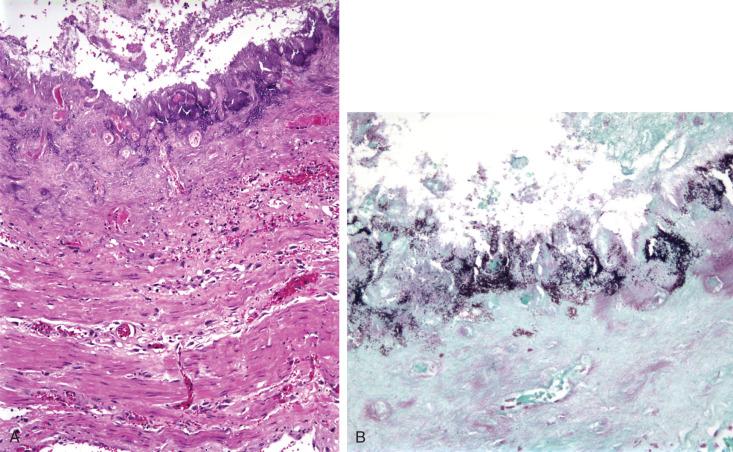
Esophageal tuberculosis is usually caused by extension of infection from contiguous organs, particularly mediastinal lymph nodes, or from miliary spread. Autopsy studies show esophageal involvement in 0.15% of patients dying with tuberculosis. Primary esophageal tuberculosis is extremely rare. The most common symptoms of esophageal tuberculosis are dysphagia, weight loss, and retrosternal pain. Imaging modalities may show extrinsic compression by involved lymph nodes in the mediastinum, traction diverticula, stricture, kinking of the esophagus, sinus or fistulous tract, and pseudotumoral masses. Chest computed tomography (CT) and endoscopic ultrasonography reveal extrinsic nodular masses, consistent with mediastinal lymphadenopathy showing central hypodensity, rim enhancement, and calcification. Endoscopic examination shows shallow ulcers with smooth border, a gray purulent base, and irregularly infiltrated edges. Synchronous endoscopic ultrasound (EUS) commonly shows matted, heterogeneous lymph nodes with hypoechoic centers.
The differential diagnosis includes carcinoma, fungal infection, syphilis, and Crohn disease. In some cases, no preoperative diagnosis is established before esophagectomy ; however, even if a developed stricture has formed, antimycobacterial treatment can successfully save the patient from a complex surgical intervention.
The characteristic histologic features of esophageal tuberculosis include necrotizing, often confluent granulomas, which can be present at any level of the esophagus ( Fig. 10.2 ). A rim of lymphocytes may be present at the periphery. In some cases, granulomas are sparse, or hyalinized and calcified. Acid-fast stains may demonstrate the organisms, but culture confirmation is often required. In a series of 32 cases, histology of the ulcers and fine-needle aspiration of lymph nodes yielded a diagnosis in 84% of the cases. Polymerase chain reaction (PCR) for M. tuberculosis can be a rewarding diagnostic approach.
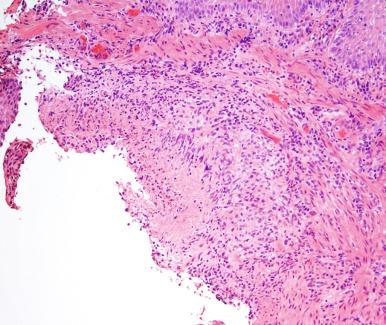
Other granulomatous conditions, including mycobacterial infection due to Mycobacterium kansasii or Mycobacterium bovis , fungal infection, and Crohn disease, should be excluded. Features favoring Crohn disease include the presence of transmural lymphoid aggregates with deep fistulas and fissures.
Fungal esophagitis is most frequently caused by Candida spp., but other pathogens, including Histoplasma , Aspergillus , Cryptococcus , Coccidioides , Paracoccidioides , Trichosporon , Blastomyces , and Mucor , can cause disease ( Table 10.1 ). Fungal infection is often superimposed on other infections, and efforts at identifying all possible pathogens are mandatory to design optimal treatment. Debilitated and immunocompromised individuals are susceptible to fungal infections, and irradiation, chemotherapy (including new targeted therapies), and chronic motility disorders are predisposing factors. Esophageal candidiasis is the most common cause of esophagitis in human immunodeficiency virus (HIV)-infected patients.
| Organisms | Morphologic Features |
|---|---|
| C. albicans | Mixture of budding yeast and nonbranching pseudohyphae; occasional septate (true) hyphae |
| C. tropicalis | |
| C. glabrata | Budding yeast |
| No hyphae | |
| No halo effect | |
| Aspergillus spp. | Septate hyphae in uniform width |
| True dichotomous branching with regular, acute angles | |
| H. capsulatum | Intracellular |
| Oval budding yeast with narrow-based buds | |
| Halo effect around organisms on H&E stain |
Candida albicans is a constituent of normal flora. Although it primarily affects patients with predisposing conditions, Candida esophagitis can occur in apparently normal hosts. A variety of Candida spp. are pathogenic, including Candida glabrata , Candida parapsilosis , Candida tropicalis , Candida stellatoidea , and Candida krusei . Of those, C. tropicalis tends to be more virulent, showing a propensity to invade submucosal blood vessels. Patients with intact immunity usually develop inflammation at the infected site that limits penetration by the microorganisms.
Acute candidal esophagitis is the most common manifestation. Presenting symptoms are nonspecific and include odynophagia, dysphagia, and retrosternal chest pain. Esophageal bleeding, perforation, stricture, sinus formation (with secondary pulmonary abscess), extensive necrosis, and systemic invasion are rare. Subacute candidal esophagitis is an uncommon disease that usually affects asymptomatic and immunocompetent patients, but it can cause esophageal strictures and pseudodiverticula. It typically follows an indolent course. Chronic candidal esophagitis is also rare and is usually seen as a feature of chronic mucocutaneous candidiasis that consists of several clinical syndromes, including autoimmune polyendocrinopathy-candidiasis-ectodermal dystrophy. These patients usually have other gastrointestinal manifestations, including malabsorption and loss of parietal cell function.
Candidal infections can result in significant morbidity and death, especially in high-risk patients. Patients who receive radiation therapy to the thorax for lung or esophageal cancer or inhaled corticosteroid for asthma or chronic obstructive pulmonary disease are predisposed to candidal esophagitis.
Candidal infections yield small, yellow-white, raised plaques with surrounding erythema in mild disease—and confluent linear and nodular plaques or membranes covering a friable, erythematous, ulcerated mucosa in extensive disease—particularly in the middle and distal esophagus. Erosion, ulcers, and strictures can develop. Fungi are densely adherent to the inflamed mucosa. In advanced disease the esophagus may become stenotic and show mucosal irregularities. In chronic cases, umbilicated, wartlike lesions may develop. The gross features are easily confused with pseudodiverticulosis, varices, or carcinoma. Rarely, fungal esophagitis leads to a botryoid appearance resembling clusters of grapes projecting from the mucosa, and mucosal bridges may form. In severe candidiasis, necrosis of the entire esophageal mucosa may be seen.
Candida spp. are characterized by a mixture of blastoconidial spores, 3 to 4 µm in diameter, and nonbranching pseudohyphae that may become quite large, up to 2 µm in diameter. True septate hyphae can also be seen. These structures are best seen with Grocott methenamine silver (GMS) or periodic acid–Schiff (PAS) stain, and the presence of all of these structures is diagnostic of Candida infection ( Fig. 10.3 ). Isolated budding yeasts without pseudohyphae or evidence of tissue invasion are often seen in inflammatory exudates at the ulcer bed; however, pseudohyphae or true hyphae are required for accurate diagnosis. Superficial colonization, particularly of nonviable tissue, does not necessarily indicate clinically significant disease. Although cytologic brushings from the plaques are more sensitive for fungal detection, biopsies are required to ascertain whether the fungus has invaded tissue. For this reason, it is important to indicate in the pathology report the types of fungal forms that are present (yeast, pseudohyphae, or both) and whether they are seen only in exudates or actually invading tissue.
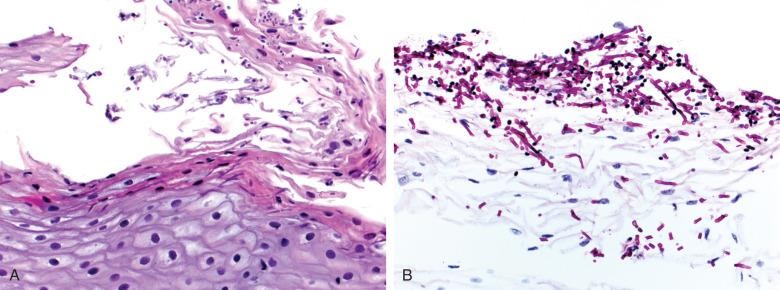
Candida infections also mimic other fungal infections, such as aspergillosis and histoplasmosis. Candida spp. can be differentiated from Aspergillus based on the width of hyphae, the presence of acute-angle dichotomous branching by Aspergillus spp., and the presence of blastoconidia in Candida infection. The presence of pseudohyphae in Candida generally differentiates it from Histoplasma capsulatum , but if only yeast forms are identified, the differentiation of Candida from Histoplasma may be difficult. However, tissue Gram stain almost always decorates the gram-positive yeast forms of Candida .
Aspergillus , which is a ubiquitous fungus, rarely causes esophagitis. Several species can infect the esophagus, including Aspergillus fumigatus , Aspergillus niger , and Aspergillus flavus . Aspergillus commonly colonizes immunocompromised patients but can invade tissues and disseminate via the bloodstream, posing a life-threatening condition. Isolated gastrointestinal aspergillosis is relatively rare but has been reported. Patients with esophageal aspergillosis present with painful or difficult swallowing and weight loss. Concurrent mucosal candidiasis may be present.
Esophageal aspergillosis typically involves the mucosa and extends into the muscularis propria. When vascular invasion occurs, thrombosis and subsequent infarction may lead to perforation. Aspergillus is characterized cytologically by the presence of acute-angle branching septate hyphae with smooth, parallel walls, ranging in size from 2 to 4 μm in diameter. Characteristic conidiophores are rarely seen in this setting. Aspergillus can be differentiated from Mucor by its uniform thickness, mode of branching, and presence of frequent septation.
Blastomyces , Histoplasma , Mucor , and Cryptococcus spp. rarely involve the esophagus and usually only in patients with disseminated disease, but esophageal infection can arise from infections in contiguous structures, such as the lungs or mediastinum. Patients with histoplasmosis can present with dysphagia resulting from esophageal compression by infected mediastinal lymph nodes or as a complication of mediastinal granuloma or sclerosing mediastinitis. Mediastinal granulomas can cause traction esophageal diverticuli.
Herpes infection may be seen throughout the gastrointestinal tract but is usually limited to squamous epithelium–lined structures (e.g., esophagus, anorectum). Herpes esophagitis has been reported with both herpes simplex virus type 1 (HSV-1) and HSV-2, and it affects 0.5% to 6% of patients, primarily those who are immunocompromised due to AIDS, transplantation, or chemotherapy. However, immunocompetent adults and neonates also develop herpetic esophagitis.
Primary infections are common in neonates with disseminated HSV. In adults the disease typically manifests as a reactivation of latent disease. Usually, a previously healthy, immunocompetent patient with a history of recurrent “cold sores” (i.e., nasolabial herpetic lesions) who presents with concurrent esophageal symptoms most likely has HSV esophagitis. In this setting, infections are self-limited. However, immunocompromised individuals may experience severe prolonged infections, and they are at risk for serious complications, including mucosal necrosis, hemorrhage, strictures, tracheobronchial fistula, and disseminated infection.
The endoscopic appearance of HSV esophagitis varies with the time of infection. Early lesions consist of rounded, 1- to 3-mm, clear vesicles seen predominantly in the middle to distal esophagus. Subsequently the epithelial roof is eroded to leave small, 1- to 3-mm ulcers. After most of the HSV-infected squamous cells have sloughed off, characteristic sharply demarcated ulcers with raised margins and a yellow-gray base are seen ( Fig. 10.4 ). The uninvolved mucosa usually appears normal. If infection progresses, the ulcers may coalesce to produce inflammatory exudates that grossly resemble Candida esophagitis.

Typical histologic findings include focal ulceration, neutrophils in the lamina propria, and an inflammatory exudate with sloughed necrotic squamous cells. Aggregates of macrophages near the ulcer are characteristic of the inflammatory response. Diagnostic cytopathic changes include nuclear molding, multinucleated giant cells, ballooning degeneration, and eosinophilic type A intranuclear inclusions showing margination of chromatin ( Fig. 10.5 ). Cowdry type B inclusions are more frequently seen than type A inclusions. The edge of the ulcer and the sloughed squamous cells are the best places to sample for identification of the characteristic cytopathic changes. Viral culture is more sensitive than microscopic examination for diagnosis of HSV infection, and the combination of directed brushings and biopsy specimens submitted for culture and histology improves the sensitivity of endoscopic diagnosis compared with biopsy alone. Accurate diagnosis can be confirmed in situ by immunostaining with commercially available specific monoclonal antibodies.
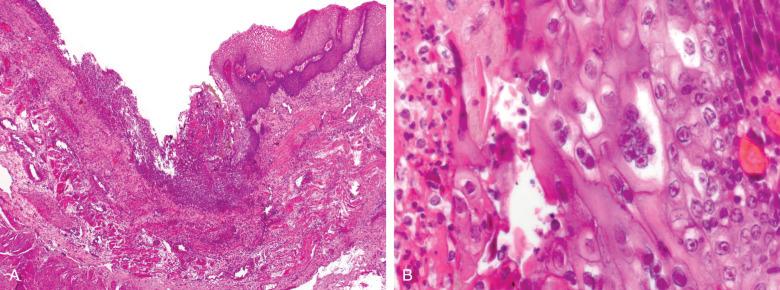
The differential diagnosis of HSV esophagitis includes other viral infections, such as cytomegalovirus (CMV) and varicella zoster virus (VZV) infection. Their histologic features overlap, so immunostains and in situ hybridization are required to accurately distinguish them. It is important to distinguish HSV from other infections because specific antimicrobial agents are required for effective treatment.
Multinucleated “reparative” squamous epithelial giant cells that are located predominantly in the proliferative basal and suprabasal zones of the preserved squamous epithelium have also been reported in the setting of reflux esophagitis, radiation therapy, and drug esophagitis. The epithelial giant cells may be confused with herpetic infection; however, the former typically lacks ground-glass nuclear inclusions and peripheral condensation of chromatin at the nuclear membrane. The multinucleated cells in herpes esophagitis are generally more prominent in the superficial aspects of the epithelium and in luminal inflammatory debris. An immunostain for herpes virus antigen can help to exclude HSV infection.
Esophagitis is the second most common gastrointestinal manifestation of CMV infection after colitis. CMV esophagitis is reported in the setting of HIV infection, renal dialysis, or organ transplant. The onset of symptoms is more gradual than that of HSV esophagitis and includes fever, odynophagia, epigastric pain, nausea, vomiting, diarrhea, and weight loss, as opposed to the painful difficulties in swallowing and retrosternal pain commonly seen in HSV infection. Endoscopically, CMV infection manifests as multiple, discrete, small, superficial ulcers in the middle or distal esophagus, but it may yield one or more large, flat, and elongated ulcers. Because HSV esophageal ulcers are rarely several centimeters in diameter, the presence of giant ulcers is suggestive of CMV esophagitis in patients with AIDS ( Fig. 10.6A ), although HIV-associated idiopathic ulcers may also become large. Penetrating giant ulcers causing fistulas and pseudotumoral lesions may be seen in AIDS patients. CMV esophagitis may coexist with both HSV and Candida infection in transplant recipients and AIDS patients.
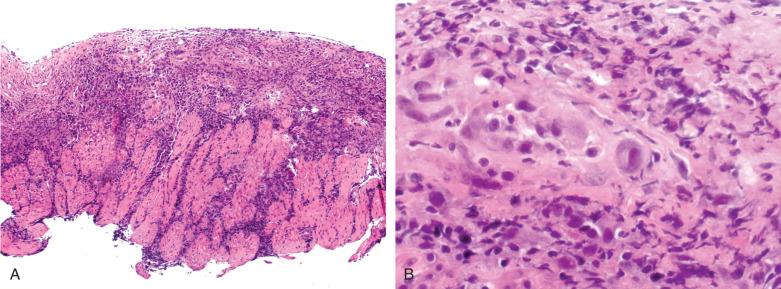
CMV cytopathic effects typically develop in endothelial cells and fibroblasts rather than in epithelial cells (see Fig. 10.6 ). Therefore superficial biopsy specimens that contain only squamous epithelium or brushings for cytology are usually insufficient for the evaluation of CMV infection, and it is recommended that biopsies include the granulation tissue of the ulcer bed. Classic cytopathic effects of CMV include intranuclear eosinophilic inclusions surrounded by a halo with margination of the chromatin to the nuclear membrane. In contrast to HSV and VZV, multiple small cytoplasmic inclusions may be seen with hematoxylin and eosin (H&E) stain and to advantage with PAS and GMS. CMV can superinfect the ulcerations caused by HSV, and mixed infections are common in severely immunocompromised individuals ( Fig. 10.7 ). Immunohistochemistry with specific antibodies or genetic probing for virus may be necessary to establish the diagnosis, especially if the patient has received antiviral agents prophylactically, because such agents can inhibit nuclear cytopathic changes.
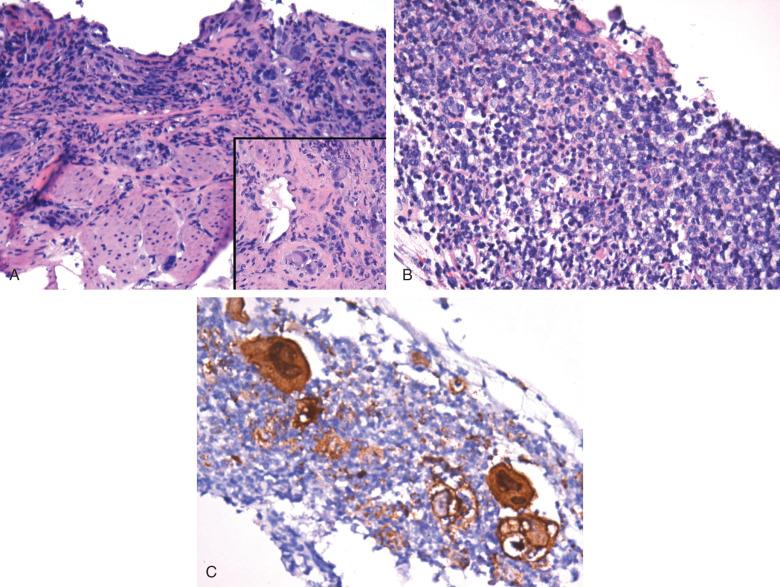
Primary VZV infection (chickenpox) in immunocompromised children is often associated with severe visceral dissemination and has a mortality rate of 7% to 30%. VZV esophagitis is rare and occurs in severely ill patients but not in AIDS patients. VZV cytopathic changes are seen in epithelium, endothelium, and stroma cells and are indistinguishable from those of HSV. Cytoplasmic rarefaction and vacuolization of the infected cells, as well as dissociation of the basal layer from the lamina propria, may be observed. To differentiate VZV infection from HSV infection, immunohistochemical staining with specific monoclonal antibodies is required.
Esophageal infections with human papillomavirus (HPV) may manifest as erythematous macules, white plaques, nodules, exuberant frondlike lesions, or even ulcerations. Large lesions can be mistaken for malignancy on endoscopic examination, and small lesions may be confused with glycogen acanthosis. Koilocytotic changes in squamous epithelium are characteristic. As in the cervix and anus, HPV infection is associated with well-defined papillomas (condylomas) and with mucosal hyperplasia.
Epstein-Barr virus (EBV) esophagitis is infrequently reported but can be seen in otherwise healthy patients with infectious mononucleosis. These patients present with odynophagia and hematemesis and develop denuded ulcers with erythema. Histologically, EBV-infected esophageal mucosa is comparable to oral hairy leukoplakia seen in AIDS patients; it is characterized by epithelial hyperplasia, parakeratosis, and koilocytosis. Deep biopsies show dense monocytic CD3-positive T cells. EBV infections confirmed by in situ hybridization are also seen in AIDS.
Esophageal ulceration is an important cause of morbidity in patients with HIV/AIDS and may result from a variety of factors. A prospective study reported that 50% of esophageal ulcers in HIV-infected patients were caused by CMV infection, and approximately 40% were classified as idiopathic ulcers. Other causes included HSV infection, gastroesophageal reflux disease, and Candida infection, noted in 24% of the cases in an African study. In 10% of patients, more than one etiology was discovered during long-term follow-up. Acute seroconversion to HIV can produce multiple small esophageal ulcers with an intense inflammatory infiltrate. Based on the ultrastructural detection of viral-like particles in biopsy samples, it was hypothesized that HIV was responsible for the ulcerations in these individuals.
Large idiopathic esophageal ulcerations, after thorough evaluation for other infectious agents, have been documented in 4% to 12% of HIV-infected patients with esophageal symptoms, especially those in late stages of AIDS. Some have suggested that HIV is causative, based on demonstration of HIV by in situ hybridization and positive immunohistochemistry and enzyme-linked immunosorbent assay (ELISA) for HIV p24 core protein in macrophages lining the ulcerations. However, HIV PCR was also positive in the majority of the examined patients with CMV esophagitis, and HIV can be cultured in approximately 50% of esophageal specimens from otherwise asymptomatic HIV-infected patients, raising doubt as to whether HIV is the cause of giant ulcerations. These patients may respond to systemic corticosteroid therapy, but treatment also predisposes patients to infectious complications ( Table 10.2 ).
| Virus | Location | Macroscopic Features | Histology |
|---|---|---|---|
| HSV, VZV | Middle to distal esophagus not extending to stomach (usually involves squamous mucosa) | Multiple small, sharply demarcated, and shallow ulcers | Epithelial ballooning and inclusions at ulcer edge; only inflamed granulation tissue in ulcer bed |
| CMV | Part of multiple organ involvement (stomach, intestine > esophagus) | Resembles HSV; occasionally one or more giant ulcers | Cytopathic effects involving endothelium, stromal cells, and/or submucosal glands; infection of squamous cells rarely seen |
| HPV | Esophagus occasionally involved | Normal, elevated lesions, or papillomas | Koilocytosis in squamous epithelium; condyloma, epithelial hyperplasia, or normal-appearing mucosa |
| EBV | Middle esophagus | Multiple small, deep, and linear ulcers | Similar to oral hairy leukoplakia; epithelial hyperplasia, parakeratosis, and koilocytosis |
| HIV | Esophageal involvement hard to document | Large ulcers or small ulcers resembling HSV | No specific changes |
Given the protective mechanism of low gastric pH, only a limited number of infectious agents have been demonstrated to thrive in the stomach, usually as a result of a high infectious burden or specific evolved protective mechanisms. Not surprisingly, immunodeficient patients are at greater risk for infectious gastritis. Although Helicobacter pylori is the most common cause of infectious gastritis, other agents also cause disease ( Table 10.3 ).
| Etiology | Clinical Setting | Histology |
|---|---|---|
| Viruses | ||
| Cytomegalovirus | Immunocompromised patients | Erosive gastritis |
| Herpes simplex virus |
|
— |
| Varicella zoster virus |
|
— |
|
— | |
| Bacteria | ||
| Streptococcus |
|
Necrotizing gastritis |
|
— | |
| E. coli | — | — |
| Enterobacteriaceae | ||
| S. aureus | — | — |
| M. tuberculosis | Endemic area | Erosive and fibrosing gastritis with necrotizing granulomas |
| H. pylori | General population | Chronic active gastritis |
| H. heilmannii | — | — |
| M. avium | AIDS | Ill-formed granulomas |
| Actinomyces | — | Suppurative and mass-forming gastritis |
| Syphilis | Sexually transmitted disease | Diffuse inflammatory gastritis |
| C. perfringens , E. coli , Streptococcus , Enterobacter , P. aeruginosa |
|
Emphysematous gastritis |
|
— | |
|
— | |
| Fungi | ||
| Candida |
|
Aphthous, or linear ulcerations or even larger ulcers |
|
||
|
— | |
|
— | |
| H. capsulatum |
|
Inflammatory mass |
| Phycomycosis |
|
Ulceration and hemorrhagic necrosis |
|
||
| Parasites | ||
| Cryptosporidiosis | AIDS | Minimal inflammation |
| S. stercoralis | Immunosuppressed patient (e.g., AIDS, diabetes) | Diffuse mucosal involvement |
| Anisakiasis | Consumption of raw shellfish | Eosinophilic and granulomatous gastritis |
| A. lumbricoides | Gastric outlet obstruction | |
Although CMV infection may occur in immunocompetent patients, gastrointestinal CMV usually occurs in immunocompromised individuals due to malignant disease, iatrogenic immunosuppression, or AIDS. In these latter settings, CMV infection can be life-threatening, whereas CMV gastritis is generally asymptomatic in many patients with mononucleosis or like syndromes in immunocompetent patients.
Clinical symptoms include epigastric pain, fever, and atypical lymphocytosis. Endoscopically the gastric mucosa is congested and edematous, with multiple erosions and ulcerations. A pattern of hypertrophic gastritis resembling Ménétrier disease and associated with protein-losing gastropathy has been described (commonly in immunocompetent pediatric patients).
The biopsy specimens demonstrate mixed inflammatory infiltrates with characteristically enlarged endothelial, stromal, or epithelial cells showing diagnostic owl's-eye intranuclear inclusions. However, cytopathic changes can be difficult to identify, and multiple granular basophilic cytoplasmic inclusions may be seen instead. It has been noted that inclusions are usually observed in the endothelial cells if the mucosa is not ulcerated, whereas they are commonly seen in endothelial and stromal cells when the mucosa is ulcerated.
Gastric involvement with HSV or VZV is rare, particularly in immunocompetent children, but may be associated with severe abdominal pain. Reactivation of infection acquired at an early age is often the result of radiation therapy, chemotherapy, or malignancies in immunocompromised patients. In the latter the infection is particularly dangerous, with a 50% to 60% fatality rate despite the use of antiviral therapy. Symptoms include nausea, vomiting, fever, chills, and fatigue. Gastroscopic examination shows erosions and multiple small ulcers, at times yielding a cobblestone appearance, with ulcerated plaques or linear superficial ulcers. Microscopic examination reveals epithelial cells with ground-glass nuclei and eosinophilic intranuclear inclusions surrounded by a clear halo. Acute gastritis due to EBV has been reported but is rarely biopsied because it may arise in the setting of infectious mononucleosis. The pathology is characterized by dense and diffuse lymphoid infiltrate with atypical lymphocytes that can mimic diffuse lymphoma. Rare cases of acute measles gastric infection with giant cells of Warthin-Finkeldey type have been described.
Acute suppurative gastritis is a rare disorder caused by bacterial infection of the submucosa and muscularis propria. In severe cases, necrotizing gastritis may result. It is associated with ethanol abuse, upper respiratory tract infection, AIDS and other immunocompromised states, and infected peritoneal-jugular venous shunts; it rarely occurs as a complication of surgical biopsy.
Patients are acutely ill with acute upper abdominal pain, peritonitis, purulent ascitic fluid, fever, and hypotension. The outcome is frequently fatal. Ultrasonography and CT may establish the diagnosis. Gastroscopic examination reveals a thick and edematous gastric wall. The mucosa may be granular with a dark green exudate. The diagnosis is commonly delayed, and the mortality rate is high. Gastric resection combined with broad antibiotic therapy directed against the most common organisms is the treatment of choice.
Microscopic examination reveals an acute suppurative inflammation and edema of the submucosa and necrosis of muscularis propria with numerous gram-positive and gram-negative organisms. Offending organisms include Streptococci , as well as S. aureus , Escherichia coli , Enterobacteriaceae , and other gram-negative bacilli. Intravascular thrombosis is common, and extensive mucosal and mural necrosis can be seen.
Emphysematous gastritis is a rare variant resulting from infection by gas-forming organisms, most commonly Clostridium perfringens , E. coli , Streptococcus , Enterobacter , and Pseudomonas aeruginosa . Predisposing factors include gastroduodenal surgery, ingestion of corrosive material, gastroenteritis, and gastrointestinal infarction. In most cases, radiographic studies show gas bubbles conforming to the contours of the stomach.
Since the introduction of pasteurization, gastric infection due to M. tuberculosis has been rare; it usually represents a secondary spread from pulmonary tuberculosis. The patient commonly presents with abdominal pain, nausea and vomiting, fever, and weight loss.
Endoscopic examination may demonstrate multiple bleeding ulcers or erosions; a narrowed, deformed antrum; and possibly gastric outlet obstruction due to a thickened wall. Microscopic examination may show an ulcerated mucosa, but the presence of necrotizing granulomas is diagnostic. The presence of acid-fast bacilli (AFB) can be confirmed on acid-fast staining, but PCR for M. tuberculosis can also be contributory. However, the mere demonstration of granuloma is not sufficient to establish the diagnosis, since gastroduodenal Crohn disease and sarcoidosis should be entered into the differential diagnosis.
Although Mycobacterium avium complex (MAC) infection is common in AIDS patients, the stomach is rarely involved. Gastric MAC may be associated with refractory chronic ulcers. Presenting symptoms include fever, night sweats, anorexia, weight loss, diarrhea, and abdominal pain. Abdominal CT scans may show mesenteric lymphadenopathy. Microscopic examination shows a lamina propria expanded by numerous foamy histiocytes. These aggregate in ill-formed, nonnecrotizing granulomas. AFB, often numerous, can be highlighted by Ziehl-Neelsen or Fite stain.
Primary gastric actinomycosis is a rare, chronic, suppurative disease. Symptoms include fever, epigastric pain, and bleeding. The stomach reveals a large, ill-defined ulcerative mass that mimics malignancy. Histologically, collections of neutrophils and sinuses are seen. A pattern of xanthogranulomatous gastritis also has been reported. Actinomyces , a gram-positive, filamentous, anaerobic bacterium, is best observed with a silver stain. The finding of sulfur granules containing long, filamentous, gram-positive bacilli is diagnostic.
Syphilitic infection of the stomach is rare but on the rise. Given the protean manifestations of this disease, gastric involvement in secondary or tertiary syphilis remains a diagnostic challenge. Endoscopic examination may show numerous shallow ulcerations with surrounding erythema, or a nodular mucosa with enlarged, thickened folds, suggestive of adenocarcinoma or lymphoma. Microscopic examination reveals severe gastritis with dense plasma cell infiltrates and varying numbers of neutrophils and lymphocytes. Gland destruction, vasculitis with endothelialitis, and ill-formed granulomas are seen. Warthin-Starry silver stain or modified Steiner stain may reveal numerous spirochetes. However, in many cases, immunohistochemistry, immunofluorescence studies, and PCR are required to establish a definitive diagnosis ( Figs. 10.8 and 10.9 ).
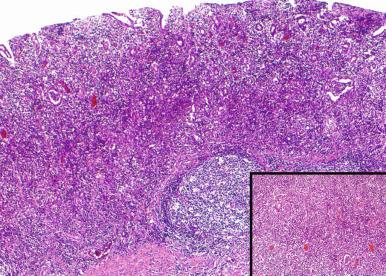
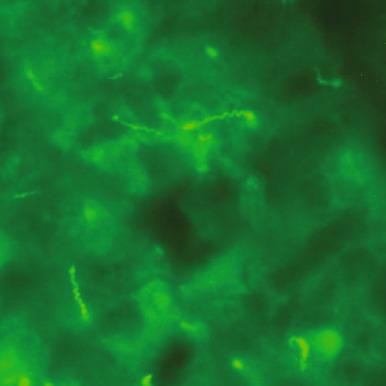
Fungal colonization of the stomach may be seen in patients with underlying malignancy or in immunocompromised patients treated with antibiotics or corticosteroids. Candida infection also occurs in alcoholic patients and in those who have ingested corrosive chemicals. The organisms can be found on H&E-stained sections but are more readily seen with PAS with diastase or silver stains. The mucosa shows multiple, aphthous, and linear ulcerations, or single or multiple larger ulcers. Microscopically the superficially necrotic, fibrinopurulent mucosa is infiltrated by yeast and pseudohyphae.
Fungal contamination of peptic gastric ulcer with Candida spp. is not uncommon and is likely of limited clinical significance, although it remains a matter of debate. These ulcers tend to be larger and are more often suspected of being malignant.
Gastric histoplasmosis is a rare condition that may manifest with hypertrophic gastric folds, masses mimicking adenocarcinoma, or small ulcerations. Biopsy shows intense infiltration by macrophages containing H. capsulatum . Fatal hemorrhage from gastric ulcer has been reported.
Gastric phycomycosis is rare and highly lethal. It is classified as either invasive or noninvasive. The former type is characterized by deep invasion of the gastric wall and blood vessels. Ulceration and hemorrhagic necrosis of the mucosa and wall, with infiltrating pigmented nonseptate hyphae, are seen.
Gastric parasitic infections are rare and are reported in specific clinical settings. For example, cryptosporidiosis has been reported in AIDS patients. The stomach is rarely affected by Strongyloides stercoralis , although colonization of peptic ulcers has been reported, and diffuse mucosal involvement may be seen in immunosuppressed patients. On biopsy, the parasite is easily identified infiltrating the mucosa.
Gastric invasive anisakiasis is commonly acquired after ingestion of raw shellfish containing the nematode larvae of Anisakis , although cases caused by Pseudoterranova spp. have also been reported in the United States. Patients typically present with epigastric pain as the parasite migrates into the gastric wall. Peripheral blood eosinophilia is not universal. Small hemorrhagic erosions are detected endoscopically, and microscopic examination shows either a phlegmonous reaction or an eosinophilic abscess with granulomatous features. The offending nematode larvae of Anisakis can be identified based on the presence of characteristic Y -shaped lateral cords and a Y -shaped intestinal lumen at midsection ( Fig. 10.10 ). The lateral cords of Pseudoterranova are characteristically butterfly shaped. Both lack the lateral alae of Ascaris larvae.
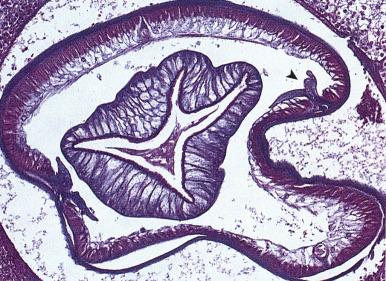
Rare examples of gastric infection by Ascaris lumbricoides have been reported in association with outlet obstruction caused by adult worms.
H. pylori is a gram-negative rod that has a propensity to infect the gastric mucosa. H. pylori are 3.5 µm long and generally comma-shaped or slightly spiral in form. The infection is usually acquired in childhood and causes chronic gastritis if the organisms are not eradicated. The majority of infected patients carry and transmit H. pylori without any symptoms. The prevalence of the infection varies worldwide, ranging from less than 15% in some cohorts to almost 100% in underdeveloped countries. Currently, despite a decrease of infection worldwide, at least 50% of the world's population is actively infected. The infection is transmitted by close personal contact.
H. pylori produces active and chronic gastritis. The lamina propria is expanded by a mononuclear cellular infiltrate, lymphocytes, and plasma cells, and lymphoid aggregates and follicles can also be seen ( Figs. 10.11 and 10.12 ). If lymphoid inflammation is prominent, the term follicular gastritis has been adopted. Normally, lymphocytes rarely enter the epithelium. Various degrees of neutrophilic infiltrate, reported as evidence of activity, may be seen. There are significant variations among infected individuals, based on host factors and the strain of infection and its associated virulence factors. Among the latter, the presence of cytokeratin-associated gene (cagA) is associated with increased inflammation and risk of developing intestinal metaplasia. H. pylori swim freely within the gastric mucus layer that overlays the apical side of the gastric surface cells, as well as in the foveolae. In patients taking proton pump inhibitors, the organism translocates deep into the gastric glands ( Fig. 10.13 ). Although H. pylori –induced damage is related to humoral and cell-mediated immune mechanisms, the morphologic activity varies significantly, from mild, with rare neutrophils seen, to severe, with glandular microabscesses.
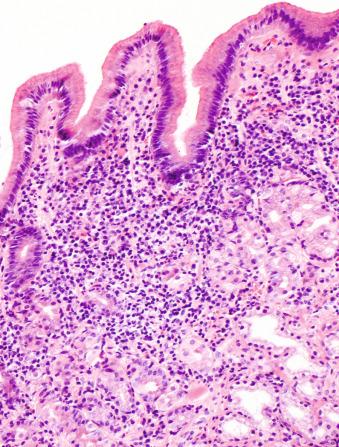
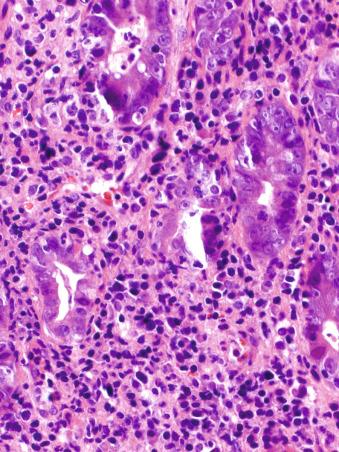
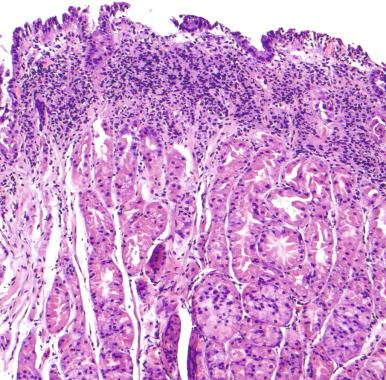
H. pylori –associated chronic gastritis includes a heterogeneous group of clinical and pathologic changes. The most common phenotype observed at our institution is a mild antral gastritis or pangastritis with limited disruption of gastric acid secretion and usually no symptoms. A second syndrome, the duodenal ulcer phenotype, shows a marked antral gastritis with high gastric secretion and preserved fundic mucosa. The patients commonly experience symptoms of duodenal ulceration.
Although approximately 90% of infected patients experience spontaneous regression, some gastritis progresses with time. Overall the lifetime risk of ulcer disease is 5% to 10%, and these patients have a 3 to 6 times increased risk of developing gastric cancer. When chronic gastritis develops, the mucosa undergoes changes that include glandular atrophy and intestinal metaplasia of the body fundus mucosa, accompanied by hypochlorhydria or achlorhydria. These changes increase the risk of gastric dysplasia and carcinoma. It has been calculated that once chronic atrophic gastritis develops, the patients have up to a 16-fold increased risk of developing gastric cancer. They are also at risk for development of mucosa-associated lymphoid tissue (MALT) lymphoma (extranodal marginal zone B-cell lymphoma).
In most cases, H. pylori can be identified in H&E-stained sections, although special stains (e.g., Giemsa, silver stains) and specific immunohistochemistry can aid in the detection of bacteria ( Fig. 10.14 ).
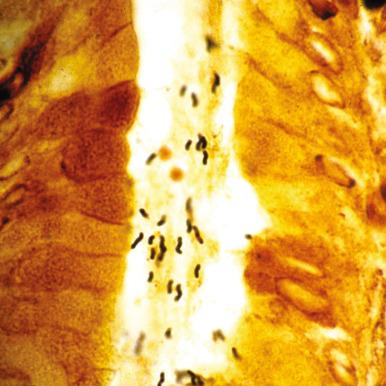
Helicobacter heilmannii is a rare cause of diffuse, antral-predominant gastritis. The organism, in the past reported as Gastrospirillum hominis , is larger than H. pylori and shows corkscrew-like spirals. The infection by the gram-negative rod may be acquired from contact with domestic pets (dogs, cats) and cattle. The patients present with epigastric pain or dyspepsia, and the endoscopy commonly shows patchy antral erythema, but in some cases pangastritis can be observed. Histologically a mild chronic, active gastritis is confined to the antrum with a 5- to 9-µm long, tightly coiled organism with corkscrew appearance present on the epithelial surface. H. heilmannii infection has been associated with the development of MALT lymphoma but not with gastric cancer. Special stains used for H. pylori also highlight this organism ( Fig. 10.15 ).
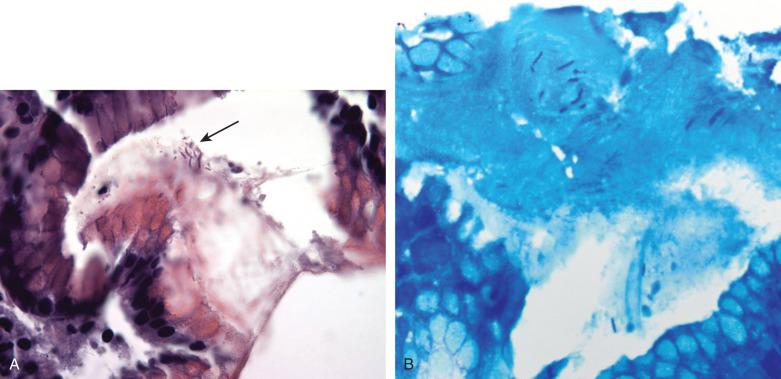
Become a Clinical Tree membership for Full access and enjoy Unlimited articles
If you are a member. Log in here